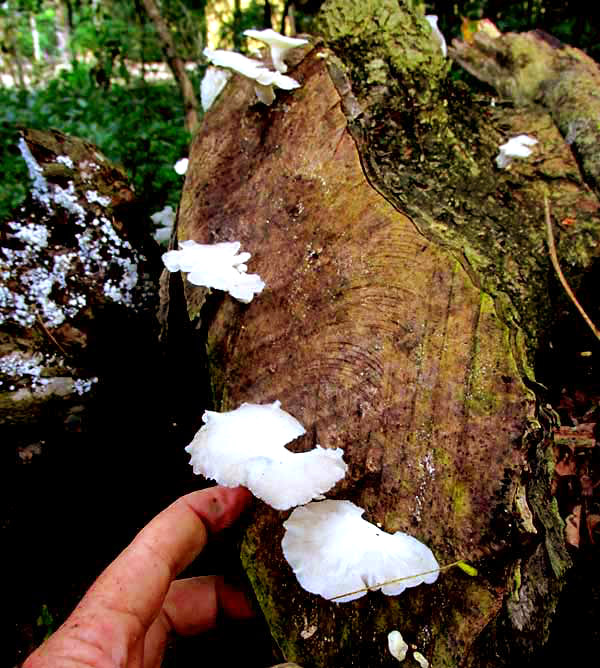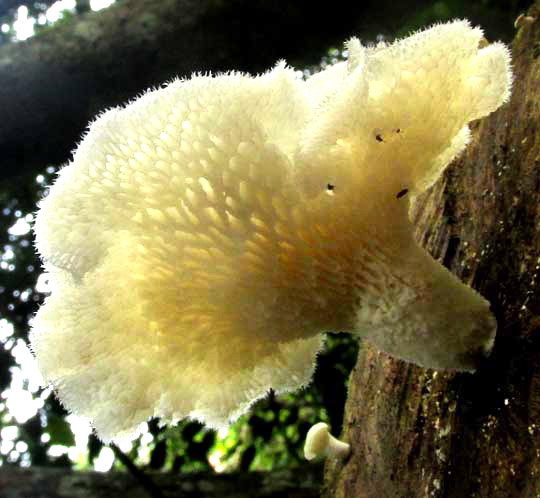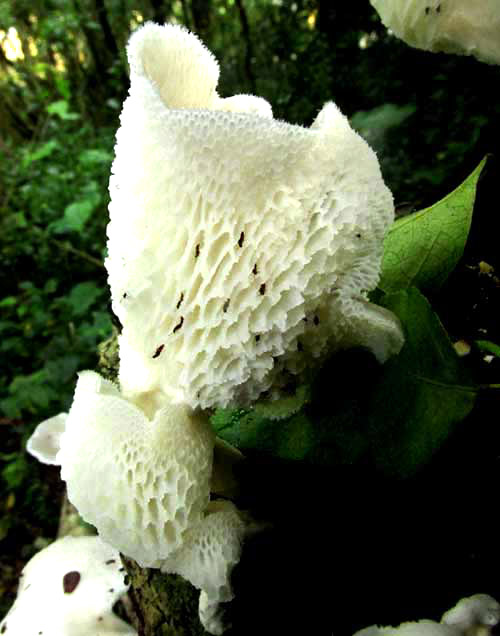Excerpts from Jim Conrad's
Naturalist Newsletter

from the November 29, 2015 Newsletter issued from Hacienda Chichen Resort beside Chichén Itzá Ruins, central Yucatán, MÉXICO
TROPICAL WHITE POLYPORE FUNGUS
The present late rainy-season sogginess also brings forth fungi not seen during the rest of the year, such as the soft-fleshed, white ones issuing from the cut face of a log stacked near the hut, shown above.
In that picture the smaller, white items populating another log at the right of the picture is a colony of slime mold, which we've already looked at, in 2012. An important field mark to note on the larger mushrooms on the cut log is that they have stalks, unlike many shelf-type mushrooms that grow from vertical wood faces. Also, the stalks arise at the cap's side, not in the cap's center, as with most stalked mushrooms. Below, you can see a shot from beneath a cap:

In this species, spores fall not from thin, flat gills on the cap's undersurface, as in the case of the best-known mushrooms, but rather from pores. The pores' honeycombed appearance is distinctive because usually pores are much smaller and with round, not elongated, openings. Also notice the hairs at the cap's edge, for most mushroom caps are hairless.
Sometimes the margins of this singular-looking mushroom's mature caps curve upward into a cup shape, providing another view of the curious pores, as shown below:

In that picture the black items nestled among the pores are insects feeding on the fungus's flesh.
Usually there's little point to try to identify a mushroom without determining its spore color, but in this case the species is so unusual, and so relatively few mushroom species are known to occur in this part of the Yucatan, that I had hope for discovering its name without taking the time to make a spore print.
Fortunately, a Google image search on the keywords "fungus white pores tropical" sufficed to quickly bring up identified images of our fungus, which were labeled as the Tropical White Polypore, FAVOLUS TENUICULUS. Until recently the species was assigned to the genus Polyporus -- thus the Polypore in the English name -- but now that huge, easy-to-recognize genus has been split into smaller, less distinctive genera, such as the current Favolus.
There's little information about Tropical White Polypores on the Internet, other than that the species is generally distributed from the Deep South part of the US southeastern states, south throughout the humid American tropics.
Also, the species is edible, though not flavorful. People add it to soups or maybe saute it with other things with more taste. The ones next to my hut were populated by so many insects that the persnickety might not want to bother nibbling on them.